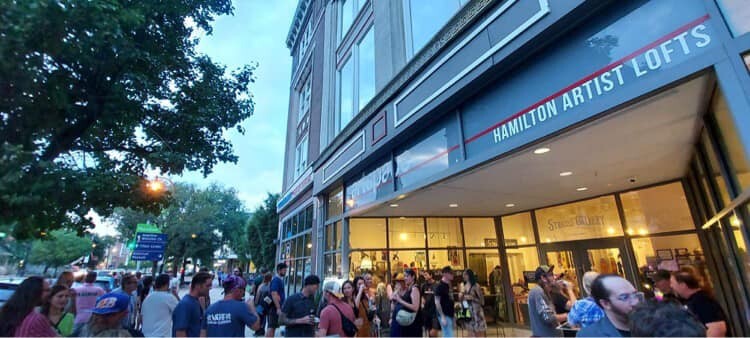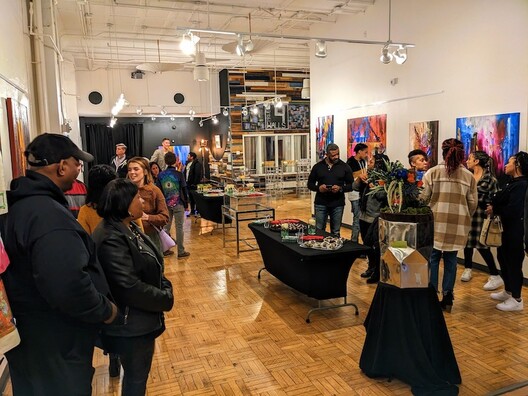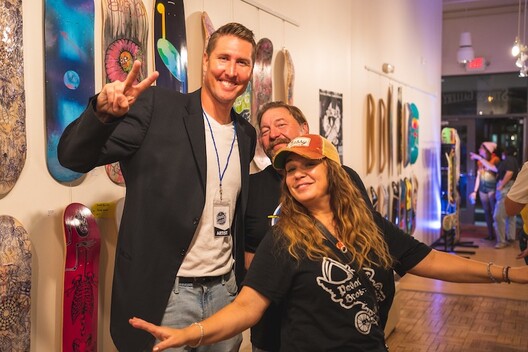Gallery Spotlight: Strauss Gallery at Artspace Hamilton, A Vibrant Creative Resource for an Arts-Oriented Suburb

The Strauss Gallery's 2022 "Decked" skateboard art exhibit, which included a recorded cameo from skateboard legend Tony Hawk, drew a big crowd inside and outside the gallery.
There’s ample evidence that communities can benefit from having a healthy arts scene. Realizing that potential, however, takes energy, initiative, and long-term commitment to connecting with new and diverse audiences.

Guests enjoy the abstract art on display at the opening night of "Project 4 Walls: The Art of Ashley Butler" at the Strauss Gallery. (See it larger)
That’s a challenge that the Strauss Gallery at Artspace Hamilton in Hamilton, Ohio, has taken up with vigor, leveraging the creative resources of a 42-unit live-work building for artists and their families. The 2,200 square-foot storefront offers a constantly changing array of exhibitions — often accompanied by live music and conversations with artists. Additionally, Artspace-hosted activities tie in with many civic, cultural, and social events in the city, about 20 miles outside of Cincinnati.
“We take great pleasure in the role that our collective gets to play towards the benefit of local artists and the impact they make in a town that genuinely celebrates them. It's part of the city of Hamilton's charm -- and if you ask me, foresight in partnering with Artspace Projects [a national nonprofit] to provide affordable housing for artists and their families in the heart of its downtown,” says David Stark, an Artspace Hamilton resident who also serves as community manager. Hamilton has actively sought revitalization through the arts; it declared itself “The City of Sculpture” in 2000, and has many installations, including a sculpture park.
An Active Calendar, Inside and Outside the Gallery
The Strauss Gallery has a full calendar, with the next few months alone featuring:
• "Project 4 Walls," an abstract art show with local artist, tour guide, and rock-climbing instructor Ashley Butler
• "Beautiful Imagination" with five renowned Cincinnati artists, including Art Attack Cincinnati leader David Estep
• The seventh annual resident art show, and,
• The "Act Your Age" exhibit of art and installations by artists of all ages, featuring "meaningful play."
In parallel, notes Stark, “our artists will be regularly seen on stages and behind easels at a slew of warm weather events in town. We are also founding partners of the Hamilton Ohio Pride and Hamilton Juneteenth Festival (both in their third years); our Artspace Hamilton resident artists are always involved in a big way.”
The gallery itself is an L-shaped space, which poses some challenges, but Stark and his colleagues have identified several wall locations that naturally draw visitors’ eyes, which are ideal for the “anchor pieces” that provide an exhibition’s focal point and frequently figure in the gallery’s social media feeds. A pair of centrally located long benches create lanes to keep visitors flowing while also providing seating; placement of food, drink, and literature towards the back of the space helps entice people in to view all the works on display.

Artspace Community Manager David Stark (at left) and friends enjoy the vibe at the opening of Strauss Gallery's "Decked" exhibition of skateboard art.
To take advantage of the location on Hamilton’s busy High Street, says Stark, “we often use a variety of props to invite people in. Sometimes, it includes posting people outside to act as barkers with flyers. And we are very active on social media, so that generally gets us a decent turnout.”
For the flyers and other materials, the gallery usually prepares a collage of work being shown, “so when people arrive, they can associate the marketing with what's before them,” explains Stark. He adds that, even after years of running exhibitions, “we are sometimes surprised at what sells and what doesn't. While we've sold a few pieces for multiple thousands of dollars, most purchases are around the $50-$250 price point. So, we encourage incoming artists to have at least have some pieces available in that range.”
A Systematic Approach Simplifies Coordination
With such an active schedule, a mostly volunteer staff, and extensive links to other community organizations, the Strauss Gallery has developed a systematic approach to its operation. This includes a shared online group calendar, notes Stark, which simplifies coordination of initial contacts with artists, media production, interviews, curation, execution, and recapping. Information for artists is provided through a platform that allows easy creation of one-page websites with links to exhibition details, applications, specifications for works to be shown, and other materials (see an example here).
For openings and other events, Stark explains, “we typically follow a formula of live music for an hour, then 20-30 minutes of programming from stage, followed by more live music and mingling. I will often interview the showcasing artist(s) from a script we've rehearsed, and we’ll frequently hear from a community partner (like a YWCA representative) who can link the work done by their organization to the art or artist that is being featured.”
The exhibition space is equipped with a Gallery System GalleryOne art hanging system that’s used for all sorts of 2-D works, as well as some 3-D pieces. “We are very pleased with our Gallery System Art Displays mounting products — they afford us the confidence to hang what we want, where we want, attractively and with great ease,” says Stark.
One challenge came with a recent showing of more than 100 skateboard decks (for which the gallery obtained a video shoutout from skateboarding icon Tony Hawk). “The skateboards came from 15 states and three countries, and were painted, mosaiced, drawn on, printed on; some had the wheels still attached and some were made into sculptures,” recalls Stark. “We had multiple rows hanging on our Gallery System, and additional boards stacked on two levels throughout the gallery. We had to use some temporary stands as well.”
The combination of physical infrastructure, personal commitment, and community connection makes the Strauss Gallery a vibrant creative presence that reaches thousands of people each year. “We make the most we can with the space we have,” concludes Stark.
